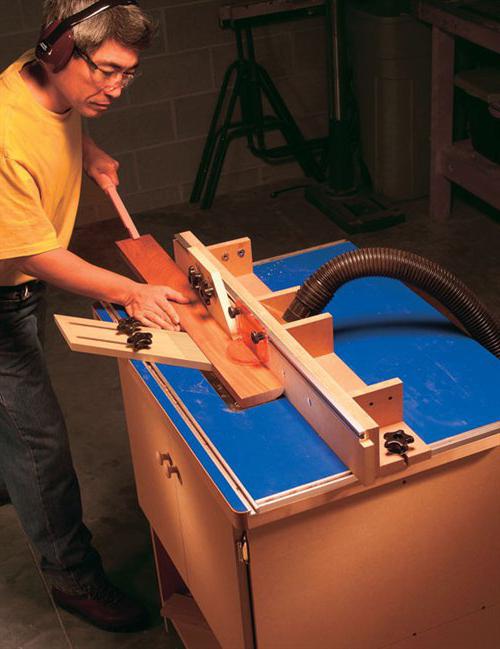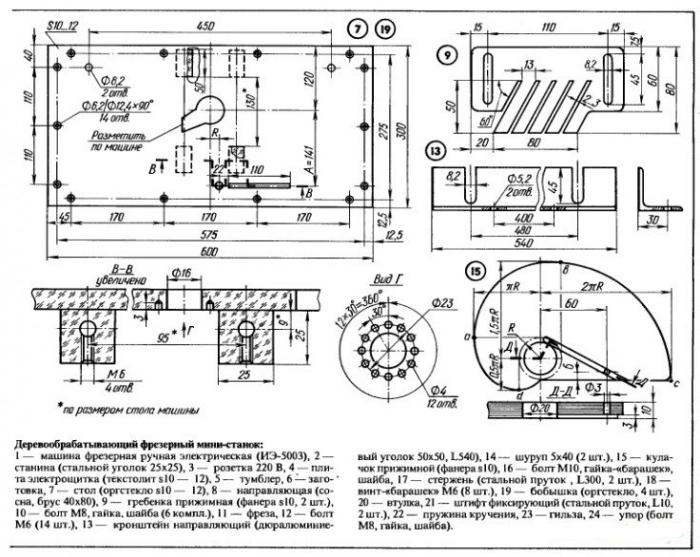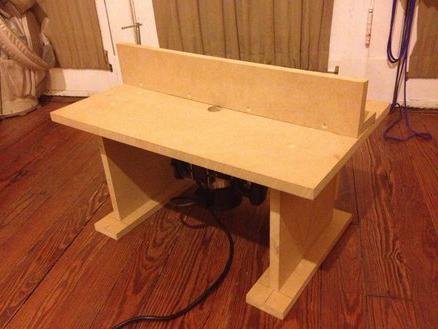The milling cutter is the most frequently used tool of a self-respecting craftsman. Thanks to him, you can make the things we know with incredible ease. There are operations in carpentry that cannot be performed without this tool.
The milling cutter consists of an engine, a collet for mounting replaceable cutters, a speed controller, and a vertical bar. In the model range of any manufacturer, there are many models with different capacities. A manual milling cutter is a fairly versatile electrical device that has a wide potential and possibilities. It becomes possible to improve the router by installing it on a horizontal surface, which will allow you to process fairly large workpieces with minimal effort.
Purpose of the milling table
Installing a router in a table or workbench allows you to achieve good results in the manufacture of many products. In the furniture industry, it is an indispensable tool. Since this process often requires trimming the edges of the canvases, making figured grooves and recesses.
Such tables can be found in large tool stores. The cost of such equipment directly depends on the functionality and material from which they are made. But even with the most minimal set of functions, but with high-quality coverage, the price for such a product is quite high. For a simple amateur who works for his pleasure in the garage, the price is unaffordable. The way out is a homemade table for the router.
Before you start buying material for the future table, you should decide on its functionality. Consider the main features of a manual milling cutter and its machine version.
Hand Router Operations
- Figured or rectilinear processing of ends or edges of preparations.
- Excavation of holes of various shapes for the installation of furniture fittings.
- Removing a quarter of the thickness.
- Grinding and cutting of workpieces.
- drilling.
- Finishing the cutting area.
- Removal of grooves of slots, grooves.
Milling table operations
A do-it-yourself table for a router allows you to perform operations such as:
- parallel fine cutting;
- facing surfaces and edges of great length;
- quarter sampling;
- edge finishing.

From the list it becomes clear that all the same operations are performed on the milling table as with a conventional manual router, but only with greater accuracy and quality. In addition, the dimensions of the blanks are already many times larger.
Choosing a hand router
For a tiny workshop, buying a separate router is an unaffordable luxury. Therefore, a router table will be required with a quick-release router design. This means that it will work in two versions, both on the table and in manual mode. To do this, you need a quality power tool.
There are two types of manual router:
- submersible;
- trimming.
Their names speak of their functionality. Since the miter router is highly specialized, its further consideration will not be interesting to the reader.
By power, an electric tool is classified into:
- low power - from 500 to 1100 watts;
- medium power - from 1200 to 1800 watts;
- high power - from 1900 to 2500 watts.
Professionals advise using low-power milling cutters for processing small workpieces, this allows you to achieve maximum ease of use. In this case, you will have to make passes in several approaches, removing a small thickness, layer by layer. However, such routers cannot be installed on a special table. For these purposes, milling machines with a power of about 2000 watts are suitable.
Also, when choosing, you should pay attention to the following features of the tool:
- the maximum depth of lowering the rack;
- smooth start;
- spindle speed control;
- dynamic brake;
- maintaining rpm under load.
- chip removal system.
All these parameters determine the quality of a manual router, which will be useful both in manual mode and in machine mode.
Milling table device

Any milling table consists of the following elements:
- directly to the milling cutter itself;
- countertops;
- parallel stop;
- chip removal systems;
- boxes for storing spare parts and various cutters;
- horizontal clamp.
Depending on the functional tasks of the milling table, it can be made in the following versions:
- side table with a milling cutter;
- stationary tabletop;
- stationary worktop with parallel stop;
- stationary worktop with rip fence, with router lift, cutter cross feed.
materials
How to make a table for a router? What should a person who decides on this business have in his arsenal? To begin with, we need a drawing of a table for a manual router. Finding him is easy. Therefore, making a table for a manual router is quite realistic. There are also many detailed tutorials and videos of local craftsmen showing off their creations. There are models that are so multifunctional that they combine, in addition to milling, drilling, grinding and cutting tables.

Almost any material is suitable for manufacturing. Basically, they use sheets of chipboard, laminated plywood or ordinary plywood with a thickness of at least 8 millimeters. You will also need wood screws with a countersunk head, aluminum corners (furniture), PVA glue.
Assembly
Consider how the simplest do-it-yourself table for a router is assembled. We will make it from laminated plywood. The size of the countertop is 400 mm wide and 400 mm long. A laminated board is perfect for a countertop. It has a number of advantages over plywood:
- wear-resistant surface;
- low cost;
- quick replacement.

However, we decided to make a table for a manual router from laminated plywood. Carefully cut it to the intended size. The legs will be made from the same material. It retreats from the edges by 20-30 centimeters and fastens the legs with the tabletop, pre-lubricate the joints with glue and make two or three holes for tightening the screws.
We make the following technological holes in the countertop:
- large round for the exit of the collet with a cutter;
- parallel groove for fastening the guide;
- you can make a small groove for attaching the ruler.
Parallel stop can be made from the same materials as the countertop. The stop consists of two parts, the interface runs exactly in the center of the installed cutter. They must move independently of each other. To increase the possibilities of milling, it is desirable that the parallel stop has two degrees of freedom. That is, he could tilt relative to the tabletop, and turn parallel to it. This will allow you to make products of complex shape.

Among other things, a recess with a square-shaped cover is made on the reverse side of the parallel stop, a vacuum cleaner pipe is inserted into one end. As a rule, the chip removal system is made from two sides, one from above behind the stop, the second directly near the milling cutter collet.
This is the easiest table for a do-it-yourself router. In the future, you can refine and install a lift for convenient adjustment of the departure in height and horizontal cutter.
Accessories
Since the router installed in the table is an electric tool, an external switch can be built into the table for safety. This will allow you to conveniently and safely turn the machine on and off when needed. Here you can also install additional sockets for connecting a portable lamp or a hand drill.

With sufficient free space, milling tables are made with dimensions of 1500 by 1500 millimeters and a height of one and a half meters. Get full-fledged workbenches. At the same time, sliding shelves are made in them, in which it is convenient to store various cutters and a key for changing the spindle. A large table allows you to process large sheets of plywood or other material so often used in the manufacture of furniture or doors. Such a table increases the accuracy of machined parts and reduces the percentage of defects in manufacturing.
Safety
It is worth remembering that tables for wood routers are sources of increased danger. The speed of the cutter reaches 25,000 rpm. Any awkward movement will lead to irreparable consequences. Hands should be kept at the maximum safe distance from the rotating head, the cutter should be changed on a stopped and de-energized machine.
When working, you need to wear special glasses that will protect your eyes from getting small chips. The noise level during operation is quite high, you should take appropriate precautions. Keep children away from the router.